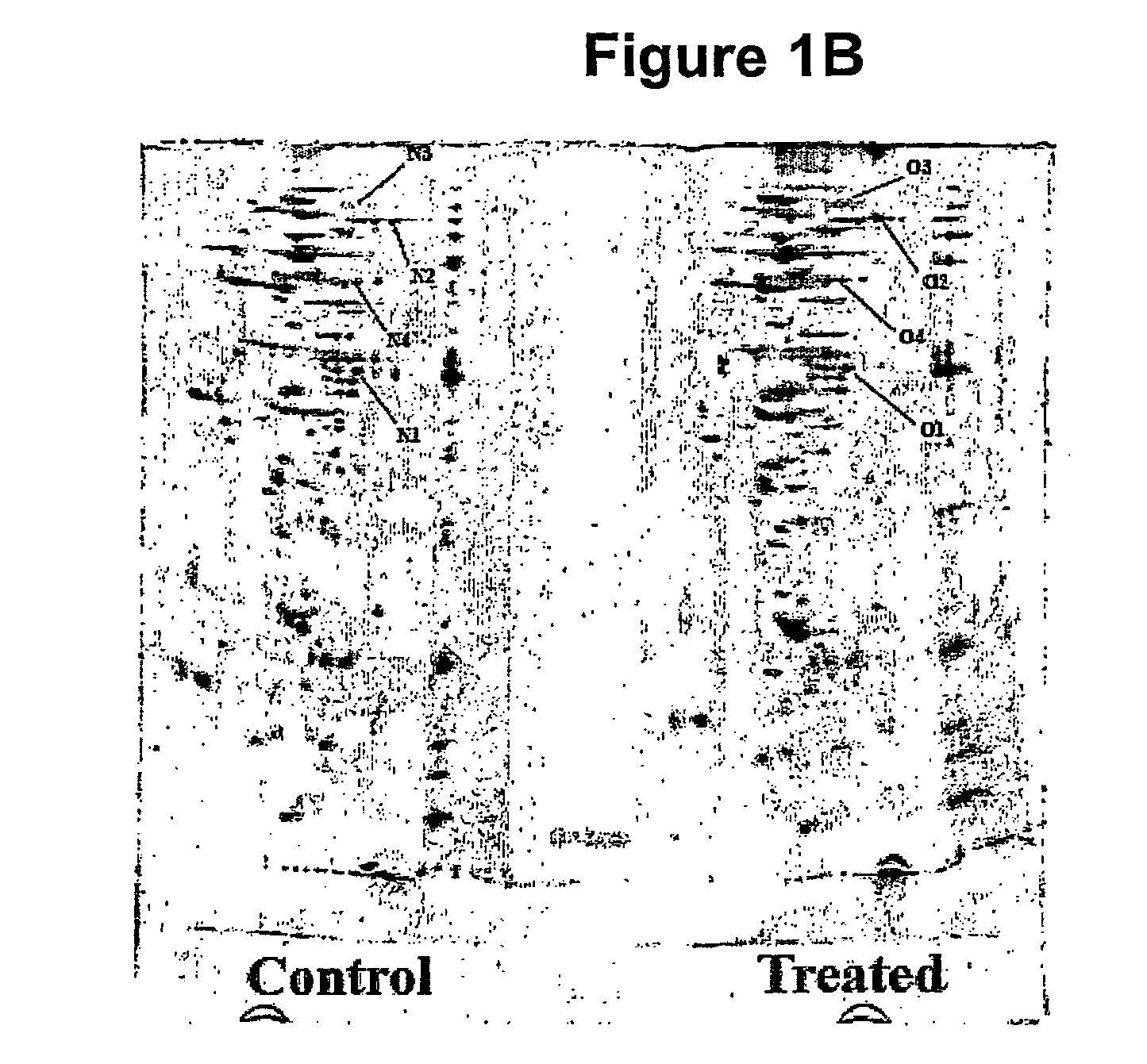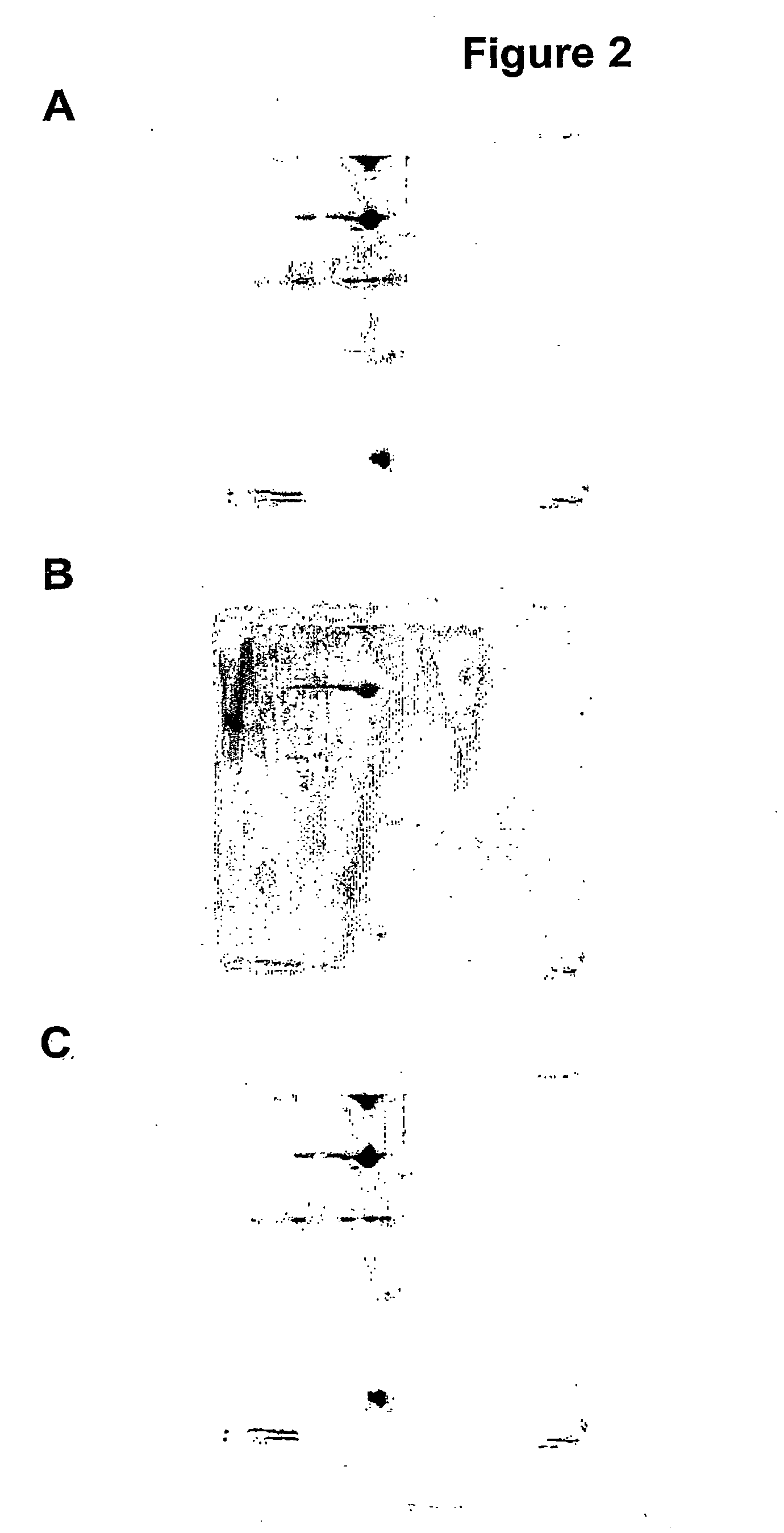Methods for determining the redox status of proteins
a protein and redox technology, applied in the field of determining the redox status of proteins, can solve the problems of poor understanding of the complexity of the system, detriment to cell viability, lack of knowledge, etc., and achieve the effect of further reducing the reliability of other proteomic techniques
- Summary
- Abstract
- Description
- Claims
- Application Information
AI Technical Summary
Benefits of technology
Problems solved by technology
Method used
Image
Examples
example 1
Detecting Protein Modifications in a Biological Sample
Materials / Methods
(i) Labels
[0114]Fluorescent Label 1 (F1) was BODIPY TMR cadaverine-IA (TMR, excitation 545 nm; emission 571 nm) and Label 2 (F2) was BODIPY FL C1-IA (FL, excitation 503 nm; emission 512 nm) (Molecular Probes). Each fluorescent label contains an iodoacetamide group covalently linked to a fluorescent BODIPY moiety. A carboxamidomethylation reaction of the iodoacetamide group to the free thiol groups of cysteine residues was carried out at pH 7.5 followed by covalent linkage.
(ii) Labelling
[0115]Jurkat cells+ / −2 mM H2O2 for 5 min in HBS buffer were extracted with RQB buffer (20% TCA in acetone, to trap thiol redox state) by resuspending the cells, using sonication (1×10 sec burst) and incubating the samples at −20° C. for 2 h. The RQB was removed by washing the protein pellet with ice cold acetone and protein samples were resuspended in MSS buffer (8M urea, 10 mM EDTA, 50 mM HEPES, 4% CHAPS and 1% pH3-10 IPG buffer a...
example 2
Analysis of Protein Modification in a Standard Protein Mixture
[0123]A set of standard proteins with known amounts of natural reduced and oxidised cysteine residues were analysed using an embodiment of the present invention.
Materials / Methods
[0124]A mixture of 25 μg each of BSA, AD, CA, OV, PEP, CytC, Cat, SOD and Lyz, were initially labelled with 1 mM label F1 for 2 h. F1 was removed and then the proteins were reduced using 5 mM TCEP and labelled with the 1 mM label F2 (in the presence of 5 mM TCEP).
[0125]Table 2 sets out the thiol properties of these proteins.
[0126]
TABLE 2FWTotalProteinAbbrev(kDa)S—HS—SS—HpIcytochrome cCytC11.60128.5-10 (bovine)lysozymeLyz14.304811.4(chick egg white)superoxide dismutaseSOD15.51135.4-6.4(bovine)carbonic anhydraseCA29.00006-7(bovine)alcohol dehydrogenaseAD36.78085.4-5.8(yeast)pepsinPEP41.41373(ovine)ovalbuminOV42.84165(chick)catalaseCat57.64045.4(bovine)albuminBSA69.3117355.3(bovine serum)
Results
[0127]ProXpress fluorescence scans of an SDS-PAGE show t...
example 3
Identification of Proteins Undergoing Redox Changes Following a Change in the Oxidising Environment
Materials / Methods
[0128]The fluorescent dyes, BODIPY® FL N-(2-aminoethyl)maleimide (FLm, Tag 1) and BODIPY® TMR C5-maleimide (TMRm, Tag 2) were used in a method to identify proteins undergoing thiol redox changes following a change in the oxidising environment.
[0129]Cells were divided into three groups and treated as follows:[0130]A. standard culture conditions[0131]B. exposed to oxidising conditions (20 μM H2O2 for 5 minutes); and[0132]C. exposed to a reduced oxygen concentration (10-20 μM) relative to standard culture conditions (where oxygen concentration is 203 μM) for 10 minutes.
[0133]The protocol, schematically reproduced in FIG. 3, was repeated over four separate experiments: With respect to the different treatments, three comparisons are possible: standard conditions to low oxygen (protocol A to protocol C); oxidising treatment to standard conditions (protocol B to protocol A); ...
PUM
| Property | Measurement | Unit |
|---|---|---|
| pH | aaaaa | aaaaa |
| pack height | aaaaa | aaaaa |
| volume | aaaaa | aaaaa |
Abstract
Description
Claims
Application Information
 Login to View More
Login to View More - R&D
- Intellectual Property
- Life Sciences
- Materials
- Tech Scout
- Unparalleled Data Quality
- Higher Quality Content
- 60% Fewer Hallucinations
Browse by: Latest US Patents, China's latest patents, Technical Efficacy Thesaurus, Application Domain, Technology Topic, Popular Technical Reports.
© 2025 PatSnap. All rights reserved.Legal|Privacy policy|Modern Slavery Act Transparency Statement|Sitemap|About US| Contact US: help@patsnap.com



